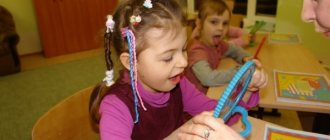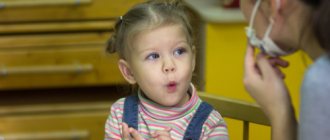Clinic La Salute Neuropsychology Mental retardation in children
Growing up, children always strive to explore everything around them and learn something new. Every day they pass through a huge amount of information. But, if the child is not very interested in this, doctors can diagnose mental retardation.
ZPR implies various difficulties in interacting with society and analyzing information. Children suffering from this disease experience significant difficulties in learning, it is difficult for them to complete the school curriculum and interact with others. Let's look at the symptoms and signs of mental retardation to understand when you should see a doctor.
Pediatric neuropsychology
What is ZPR
Mental retardation is a slowdown in the normal rate of mental development, when a child exhibits disturbances in attention, thinking, motor skills, and emotional manifestations.
Often the pathology is expressed in decreased concentration, poor memory, immaturity of thinking and rapid fatigue. If a child at the age of 4 has a delay in one of these areas, this may be a symptom of mental retardation.
Some types of illness exhibit the following disorders:
- hyperexcitability;
- hypertensive abnormalities;
- cerebrasthenic complications;
- hydrocephalic problems.
In other cases, delayed intellectual and psychological development predominates.
"Plant mysteries"
The game helps to form voluntary attention and conceptual thinking.
Required equipment: forfeits.
◈ How do we play: is the whole family gathered together? Then let's play! The presenter (at first it will be an adult) points to each player in turn and says: “Flower, tree, fruit, flower...”.
◈ The player on whom the counting stops must quickly name the plant, in this case a flower (for example, chamomile or rose), etc.
◈ The answer is correct - the game continues. If the answer is incorrect or the name is repeated (delayed response is also considered a violation), then the player gives his forfeit to the presenter and is eliminated from the game.
◈ The game continues until one player remains. He and the presenter are playing out what each “fanta” should do - sing a song, dance, crow... That will be fun!
◈ Let's consolidate: this game can be played both at home and on the road (if you are not driving). Change the theme: fish, bird, animal or wood, glass, iron. Imagine!
◈ Let’s make it more complicated: a child can be the leader.
Types and classification
ZPR, as a rule, is divided into 4 categories, which differ both in the causes of occurrence and in the characteristics of the course of the disease. Determining the type of disease is necessary to develop an effective treatment regimen.
ZPR of constitutional origin
This type can be described as mental infantilism. The child behaves as if he is younger than he actually is. Underdevelopment can be detected even at an early age by the following symptoms:
- lack of independence and feeling of security without parents;
- difficult adaptation;
- frequent mood swings;
- too strong display of emotions.
Children suffering from mental retardation of constitutional origin do not differ visually from their peers, however, they are less developed emotionally. This directly affects learning ability.
ZPR of somatogenic origin
Unlike the first type, children with mental retardation of somatogenic origin have a weakened body. Severe diseases suffered at an early age directly affect the central nervous system, delaying its development. Signs of pathology:
- loss of attention and concentration;
- rapid physical and mental fatigue;
- lack of interest in the outside world;
- constant anxiety;
- passive behavior.
Such children are often placed on an individualized regimen of education and physical activity. The child is less present in the group, as a result of which his socialization worsens.
ZPR of psychogenic origin
This type of mental retardation is based on attention deficit or overprotection, which provokes the following symptoms of mental retardation in children:
- shyness;
- fear of expressing feelings and emotions;
- changeable mood;
- emotional instability;
- aggressiveness.
A child who does not receive proper attention and does not have the opportunity to see normal family relationships interacts poorly with peers, which leads to a lack of socialization and further difficulties with communication.
ZPR of cerebral-organic origin
A characteristic feature of this type is immaturity of emotionality and cognitive activity. Symptoms are individual and depend on the degree, nature and location of damage to the central nervous system, but the main ones are considered to be:
- increased suggestibility;
- lack of imagination;
- irretention;
- lethargy;
- lack of brightness of emotions.
Since patients have minor impairments in brain function, children can still fully communicate with peers and easily socialize, but for this they should visit a specialist.
Factors in the formation of the socio-psychological climate
Self-education is the necessary spontaneous desire of a person or organization to change the internal database and knowledge base. To organize self-education, it is necessary to use the manager’s working time. Organizing self-education consists of setting goals, determining priorities (main directions), choosing a method and ensuring regularity of work on oneself.
An important task in developing the problem of ZPR is to understand its cause-and-effect relationships. The concepts of “factor” and “cause” are ambiguous. No isolated factor by itself can be the cause. Any change in state is determined by “internal moments” - the attitude of the organism (individual) to the pathogenic factor (G.E. Sukhareva).
Not every negative experience should be qualified as a factor that forms mental retardation, since the degree of significance of the factor depends on the intrapsychic characteristics of the child’s personality and his family.
After analyzing the multiplicity of approaches to studying the causes of mental retardation, the complexity of the mechanism of its formation becomes obvious. Specific manifestations of mental retardation in a child depend on the causes and time of its occurrence, the degree of deformation of the affected function, and its significance in the general system of mental development. Thus, we can identify the following most important groups of reasons that can cause PPD:
1) biological reasons that prevent normal and timely maturation of the brain;
2) a general lack of communication with others, causing a delay in the child’s assimilation of social experience;
3) lack of full-fledged, age-appropriate activities that give the child the opportunity to effectively “appropriate” social experience and timely formation of internal mental actions;
4) social deprivation, which prevents timely mental development.
From the above classification it is clear that three of the four groups of causes of mental retardation have a pronounced socio-psychological character. A child’s mental retardation can be caused by either a single unfavorable factor or a combination of factors that develop during the interaction process.
The interdependence of the social and biological causes of mental retardation is considered as the basic basis for the study. A systematic approach helps to overcome the disunity that still exists to one degree or another in medical and psychological research that isolates any one of the many aspects of the problem.
Symptoms and signs of development of children with mental retardation
Often, mental retardation can be identified only when a child is sent to first grade, because it is then that all the difficulties with studying and learning information are revealed. But with proper monitoring, some symptoms are noticeable much earlier.
Intelligence
Intellectual disability in children affects the following aspects:
- attention;
- memory;
- thinking;
- speech.
Also, under the influence of the disease, the perception of the surrounding world disappears or becomes inaccurate and slow. As a result, it is difficult for the child to form complete images. Children with mental retardation have the worst developed auditory perception, so the teaching format using live speech is the least effective.
Attention
Children suffering from mental retardation cannot concentrate their attention on one object for a long time. They do it superficially. Any extraneous factors can distract them.
Memory
Children with this disease cannot choose from the information they hear exactly what they need to remember. Their memory is visual-figurative and mosaic.
Thinking
These children think best in a visual and actionable format. For example, it is easier for them to count numbers on specific, existing objects. Their imaginative thinking is not developed, and abstract-logical thinking is completely absent. They cannot analyze and compare information, as well as formulate conclusions and conclusions.
Speech
Children with mental retardation often experience delayed psycho-speech development, that is, they distort the articulation of many sounds, experience difficulties with vocabulary, control of grammar and formulation of the correct statement. This is often combined with dyslexia and dyslalia. The difficulty is that it is necessary to identify the problem and begin treatment as early as 3 years old in order to avoid deterioration in speech skills.
Emotions
A child with this disease is usually very unstable in his emotions. His mood often changes, and his mind is easily suggestible. Manifestations of aggressiveness, poor coordination and motor skills, anxiety and conflict are also possible. Such children are generally withdrawn, self-contained and avoid contact with peers.
Physical parameters
Height and weight below normal are another sign of mental retardation. Outwardly, a child with pathology often looks several years younger.
“It looks like it doesn’t look like it”
The game teaches children to carefully examine objects and identify their common and distinctive features.
Necessary equipment: a couple of similar toys, for example: a tractor and a car, a doll and a tumbler.
◈ How to play: invite your child to compete to see who can find similar toys faster. Find them together and ask the child to first say how they are similar (for example: the bunny and the bear have fluffy legs, ears, tails, eyes, etc.), and then how they differ from each other (the bear is big, the ears are small, brown ; bunny - small, white, long ears).
◈ Let’s complicate it: take two pairs of toys that are more similar to each other - a large and a small ball, two cars of different brands, etc.
◈ We consolidate: you can play the game “Eagle Eye” on the road, in a store, at the dacha - who will find the most similarities and differences in clothes, vegetables, trees, etc. For example, compare the leaves of poplar, birch, maple, larch. The one who finds the most similarities and differences among them will win. And if you “don’t notice” something, but the child does, he will get real pleasure from the game. Don’t be afraid to play along with your little “I want to know it all” sometimes!
Features of behavior at a certain age
Baby
As a rule, children with mental retardation later than others begin to hold their heads up, walk and talk independently. There is also excessive excitability, increased or decreased appetite, insomnia and gastrointestinal diseases.
Preschooler
With pathology, children aged 4–6 years do not understand the rules of most children's games and the norms of behavior in public places. Show excessive, inappropriate emotions and have difficulty communicating.
Schoolboy
Children with mental retardation who have entered the first grade find it difficult to study. They need more time to analyze the information received, especially in conditions that interfere with concentration. They often forget about the goal they are pursuing, are quickly distracted, and cannot concentrate. It is also worth noting that with high mental stress, the child experiences emotional and physical discomfort.
"We decorate the Christmas tree"
Necessary equipment: New Year's toys.
◈ How to play: are you decorating a Christmas tree? Play with your baby. Invite him to choose from 4-6 balls exactly the same (in color, size, design) as the one in your hands. Or choose the same cracker as yours, or a serpentine of the same color. Or maybe you have New Year's houses or bunnies - take your pick. Change roles, make mistakes, let the child correct you.
◈ Fastening: what about New Year’s gifts? Let the child choose the same one from 10 candies as you have in your hands. Switch roles. Remember the New Year's poems along the way, there are many of them.
Who can diagnose mental retardation?
The diagnosis can only be made by the PMPK - the psychological, medical and pedagogical commission. A pediatrician, psychologist, speech therapist, neurologist and other doctors can identify the problem and refer the child for examination. You need to take tests and conduct various tests. For example, check for the presence of traumatic brain injuries and stress that could affect the development of the psyche, and take a neuropsychological test.
Once the diagnosis is confirmed, recommendations are given for education and schooling. You can see the problem from an experienced specialist at our La Salute clinic. A neuropsychologist with extensive experience will help you here - Danilina Kamilla Kasimovna. This is a practicing doctor, an employee of the Scientific and Practical Center for Child Psychoneurology, who has published more than 30 works on child psychology. Treatment is carried out with the help of physiotherapy and exercise therapy, special medications.
The difference between mental retardation and mental retardation
Mental retardation and mental retardation are similar diseases, but they have a number of differences, which are described in the table.
| ZPR | UO |
| Has spasmodic dynamics of intellectual activity | Not characterized by developed emotionality |
| The disease develops difficulty with intellectual activity | Difficulty with mental operations develops |
| With the right approach, you can correct your baby’s behavior and development. | There is no perception of the playful presentation of information, the child is not able to accept help in performing tasks, does not feel the desire to analyze and understand the information read |
If a child over 10 years of age does not show signs of mental retardation, his diagnosis may be changed to either mental retardation or constitutional infantilism.
How to recognize mental retardation in a child
As a child grows up, he acquires many new skills and strives to explore the world around him. If he is alienated and has any of the symptoms listed above, you need to visit specialists for examination and diagnosis.
You cannot draw conclusions about your baby’s illnesses on your own. There are many reasons and factors that can influence a child’s behavior and perceptions. Qualified specialists must confirm the diagnosis and prescribe treatment and adjustment methods.
Clinic La Salute offers a proven program for correcting the condition of children with mental retardation. We have the conditions necessary to diagnose and correct the disease in the early stages, which helps prevent further deterioration in the child’s psychological health.









